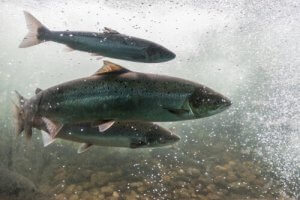Infectious Salmon Anemia: All You Need to Know


Written and verified by the biotechnologist Alejandro Rodríguez
Salmon farms first reported cases of infectious salmon anemia in the 1980s. Today, this viral disease has caused the mortality rate in some salmon breeding farms to increase to close to 90%. This article will provide more information on the virus itself, the symptoms it causes, and its diagnosis.
The history of infectious salmon anemia
Salmon farms first identified cases of this disease in Norway in the mid-1980s. Until then, infectious salmon anemia was unheard of. All the affected fish were all of the same species, Salmo salar, also known as Atlantic salmon.
Due to the fishes’ symptoms, their first diagnosis was hemorrhagic renal syndrome. However, the condition then became known as infectious salmon anemia, or ISA, when scientists diagnosed more cases and discovered the causative agent.
As time has passed, Canada, Scotland, the United States and the Faroe Islands have all seen outbreaks of this disease. A common factor in all cases was that the affected fish came from salt-water farms. As a result, all affected farms suffered a significant financial loss.

What causes infectious salmon anemia?
The infectious salmon anemia virus, or ISAV, causes this condition. The virus belongs to the Orthomyxoviridae family, which is a group of viruses that also includes the flu virus. These viruses only affect vertebrates.
If farms don’t detect ISAV in time, the virus can cause a very high mortality rate in salmon. Initially, the rate of mortality is only estimated at 1%. However, without effective control methods, some farms have reported mortality rates of almost 90% over just a few months.
In addition, this condition doesn’t affect just Atlantic salmon. It also affects other aquatic species, such as silver salmon (Oncorhynchus kisutch) and rainbow trout (Oncorhynchus mykiss). The virus doesn’t harm humans.

Symptoms and transmission
There are several symptoms that can indicate the presence of ISAV. The most common are:
- Darkening of the skin
- Tiredness
- Bleeding from blood vessels in the eyes
- Severe anemia, which gives the fish’s fins a pale color
- In some cases, the fish’s spleens and livers become abnormally enlarged
Controlling the spread of this virus is one of the biggest challenges. When the virus occurs in a tank, it spreads very quickly among the fish in that tank. Furthermore, it can also spread between different tanks, although this doesn’t happen as quickly.

Is the condition treatable?
As this is a viral disease, there aren’t as many drug or veterinary treatments as there are for other diseases. In fact, the most effective treatments involve biological control methods, combined with tough farm hygiene and disinfection measures. The aim of these is to reduce the recurrence of the virus.
There are a couple of special cleaning products that are used for disinfecting the tanks and equipment. In addition, farm staff who come into contact with the salmon can also use these products. If the condition occurs, staff should immediately remove the affected fish from the tanks. The most effective prevention method is to isolate both the farm and the affected tanks. This will subsequently help to prevent the virus from spreading.
In spite of all these measures, some fish farms have suffered significant financial losses. As a result, infectious salmon anemia has caused considerable alarm in the salmon industry in recent years.
Salmon farms first reported cases of infectious salmon anemia in the 1980s. Today, this viral disease has caused the mortality rate in some salmon breeding farms to increase to close to 90%. This article will provide more information on the virus itself, the symptoms it causes, and its diagnosis.
The history of infectious salmon anemia
Salmon farms first identified cases of this disease in Norway in the mid-1980s. Until then, infectious salmon anemia was unheard of. All the affected fish were all of the same species, Salmo salar, also known as Atlantic salmon.
Due to the fishes’ symptoms, their first diagnosis was hemorrhagic renal syndrome. However, the condition then became known as infectious salmon anemia, or ISA, when scientists diagnosed more cases and discovered the causative agent.
As time has passed, Canada, Scotland, the United States and the Faroe Islands have all seen outbreaks of this disease. A common factor in all cases was that the affected fish came from salt-water farms. As a result, all affected farms suffered a significant financial loss.

What causes infectious salmon anemia?
The infectious salmon anemia virus, or ISAV, causes this condition. The virus belongs to the Orthomyxoviridae family, which is a group of viruses that also includes the flu virus. These viruses only affect vertebrates.
If farms don’t detect ISAV in time, the virus can cause a very high mortality rate in salmon. Initially, the rate of mortality is only estimated at 1%. However, without effective control methods, some farms have reported mortality rates of almost 90% over just a few months.
In addition, this condition doesn’t affect just Atlantic salmon. It also affects other aquatic species, such as silver salmon (Oncorhynchus kisutch) and rainbow trout (Oncorhynchus mykiss). The virus doesn’t harm humans.

Symptoms and transmission
There are several symptoms that can indicate the presence of ISAV. The most common are:
- Darkening of the skin
- Tiredness
- Bleeding from blood vessels in the eyes
- Severe anemia, which gives the fish’s fins a pale color
- In some cases, the fish’s spleens and livers become abnormally enlarged
Controlling the spread of this virus is one of the biggest challenges. When the virus occurs in a tank, it spreads very quickly among the fish in that tank. Furthermore, it can also spread between different tanks, although this doesn’t happen as quickly.

Is the condition treatable?
As this is a viral disease, there aren’t as many drug or veterinary treatments as there are for other diseases. In fact, the most effective treatments involve biological control methods, combined with tough farm hygiene and disinfection measures. The aim of these is to reduce the recurrence of the virus.
There are a couple of special cleaning products that are used for disinfecting the tanks and equipment. In addition, farm staff who come into contact with the salmon can also use these products. If the condition occurs, staff should immediately remove the affected fish from the tanks. The most effective prevention method is to isolate both the farm and the affected tanks. This will subsequently help to prevent the virus from spreading.
In spite of all these measures, some fish farms have suffered significant financial losses. As a result, infectious salmon anemia has caused considerable alarm in the salmon industry in recent years.
All cited sources were thoroughly reviewed by our team to ensure their quality, reliability, currency, and validity. The bibliography of this article was considered reliable and of academic or scientific accuracy.
- Amos, K. H., Gustafson, L., Warg, J., Whaley, J., Purcell, M., Rolland, J., … & Kerwin, J. (2014). US response to a report of infectious salmon anemia virus in western North America. Fisheries, 39(11), 501-506.
- Mardones, F. O., Perez, A. M., & Carpenter, T. E. (2009). Epidemiologic investigation of the re-emergence of infectious salmon anemia virus in Chile. Diseases of Aquatic Organisms, 84(2), 105-114.
This text is provided for informational purposes only and does not replace consultation with a professional. If in doubt, consult your specialist.








